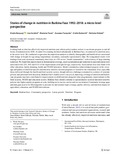| dc.contributor.author | Becquey, Elodie | |
| dc.contributor.author | Sombié, Issa | |
| dc.contributor.author | Touré, Mariama | |
| dc.contributor.author | Turowska, Zuzanna | |
| dc.contributor.author | Buttarelli, Emilie | |
| dc.contributor.author | Nisbett, Nicholas | |
| dc.coverage.spatial | Burkina Faso | en |
| dc.date.accessioned | 2022-07-15T07:54:05Z | |
| dc.date.available | 2022-07-15T07:54:05Z | |
| dc.date.issued | 2022-03-22 | |
| dc.identifier.citation | Becquey, E.; Sombié, I.; Touré, M.; Turowska, Z.; Buttarelli, E. and Nisbett, N. (2022) ' Stories of Change in Nutrition in Burkina Faso 1992–2018: a Micro-level Perspective', Food Security, DOI: 10.1007/s12571-022-01274-z | en |
| dc.identifier.uri | https://opendocs.ids.ac.uk/opendocs/handle/20.500.12413/17536 | |
| dc.description.abstract | Looking back at what has effectively improved nutrition may inform policy makers on how to accelerate progress to end all forms of malnutrition by 2030. As under-five stunting declined substantially in Burkina Faso, we analyzed its nutrition story at the micro-level. We conducted a regression-decomposition analysis to identify demographic and health drivers associated with change in height-for-age using longitudinal, secondary, nationally-representative data. We triangulated results with findings from semi-structured community interviews (n = 91) in two “model communities” with a history of large stunting reduction. We found that improvement in immunization coverage, assets accumulation and reduction in open defecation were associated with 23%, 10% and 6.1% of the improvement in height-for-age, respectively. Associations were also found with other education, family planning, health and WASH indicators. Model communities acknowledged progress in the coverage and quality of nutrition-specific and nutrition-sensitive sectoral programs co-located at the community level, especially those delivered through the health and food security sectors, though delivery challenges remained in a context of systemic poverty and persistent food insecurity. Burkina Faso’s health sector’s success in improving coverage of nutrition and healthcare programs may have contributed to improvements in child nutrition alongside other programmatic improvements in the food security, WASH and education sectors. Burkina Faso should continue to operationalize sectoral nutrition-sensitive policies into higher-quality programs at scale, building on its success stories such as vaccination. Community leverage gaps and data gaps need to be filled urgently to pressure for and monitor high coverage, quality delivery, and nutrition impact of agriculture, education, and WASH interventions. | en |
| dc.language.iso | en_US | en |
| dc.publisher | Springer Link | en |
| dc.relation.ispartofseries | Food Security; | |
| dc.rights.uri | http://creativecommons.org/licenses/by/4.0/ | en |
| dc.subject | Nutrition | en |
| dc.title | Stories of Change in Nutrition in Burkina Faso 1992–2018: a Micro-level Perspective | en |
| dc.type | Article | en |
| dc.rights.holder | © The Author(s) 2022 | en |
| dc.identifier.externaluri | https://link.springer.com/article/10.1007/s12571-022-01274-z | en |
| dc.identifier.team | Health and Nutrition | en |
| dc.identifier.doi | 10.1007/s12571-022-01274-z | |
| dcterms.dateAccepted | 2022-02-13 | |
| rioxxterms.funder | Default funder | en |
| rioxxterms.identifier.project | Default project | en |
| rioxxterms.version | VoR | en |
| rioxxterms.versionofrecord | 10.1007/s12571-022-01274-z | en |
| rioxxterms.funder.project | 9ce4e4dc-26e9-4d78-96e9-15e4dcac0642 | en |


